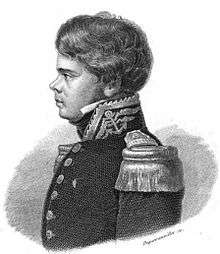Jules de Blosseville
| Jules de Blosseville | |
|---|---|
 | |
| Born | 29 July 1802 |
| Died | August 1833 (presumed) |
| Nationality | French |
| Occupation | Naval officer, explorer |
Jules-Alphonse-René Poret baron de Blosseville (born 29 July 1802 – August 1833) was a French naval officer, geographer and explorer. Born in 1802, he joined the French Navy at the age of 16. From 1822 to 1825, he participated in a French expedition that circumnavigated the world. He disappeared in August 1833, while in command of his own expedition to the Arctic.
Biography
De Blosseville was born on 29 July 1802 in Rouen, Normandy, the son of a vicomte. He joined the French Navy in 1818 and, as an officer, joined an expedition to the West Indies aboard the Railleur. In August 1822, he was a junior officer on Louis Duperrey's expedition aboard La Coquille to explore the Pacific.[1] With the expedition, he sailed to South America and rounded Cape Horn on 31 December 1822 and travelled along the coast to Peru, conducting hydrographic surveys. They reached Tahiti in May 1823.[2] While in the Tahiti region, de Blosseville became acquainted with Captain John Dibbs of the colonial barque Endeavour and returned to Maupiti Island to map it for the expedition.[3]
The expedition moved onto to Tonga, the Solomon Islands, Timor, and Australia, attained in January 1824. They later visited New Zealand, the Gilbert and Ellice islands, and the Carolines, discovering the previously unmapped islands of Mokil and Losap before moving onto the Dutch East Indies. They began their way home in September 1824, reaching Marseilles in March 1825.[2] During the voyage, Duperrey named an island in the Schoutens, near New Guinea, for Blosseville although it is no longer known by this name.[1]
Blosseville wrote a report on New Zealand which was published in 1826, first as part of a periodical and then as a separate document. Further reports followed, the last of which was published in 1829.[1] By this time, he was aboard the Alacrity, serving in the Mediterranean. He was present at the Battle of Algiers in 1830.[1]
Blosseville submitted a request to undertook an expedition exploring the Arctic, which was approved in 1833. He duly departed he as commander of Lilloise and made his way to Greenland.[1] He carried out mapping along the east coast. His ship became damaged and he put into Iceland for repairs. Once this work was completed, he departed for Greenland.[4] His expedition then disappeared, its last known sighting being made on 15 August 1833.[1] In the following years, three expeditions were mounted to him and the 83 other men of his command but no trace was found.[4] In January 1846, it was reported that the Lilloise had been wrecked on Vanikoro, in the Solomon Islands.[5] This report was later dismissed as having been made in error, given the last sighting of the Lilloise and the supposed location of the wreck.[3]
He is commemorated in the name of the Blosseville Coast, the inhospitable coast of southeast Greenland between the fjord Kangerdlugsuaqq 68°N and Cape Brewster 70° 10'N.
See also
Notes
- 1 2 3 4 5 6 Dunmore 1992, pp. 30–31.
- 1 2 Dunmore 1992, pp. 91–92.
- 1 2 de Blosseville, Ernest Poret (1854). Jules de Blosseville (in French). Evreux: A. Herissey.
- 1 2 Mills 2003, p. 234.
- ↑ "Shipping Intelligence". The Aberdeen Journal (5114). Aberdeen. 14 January 1846.